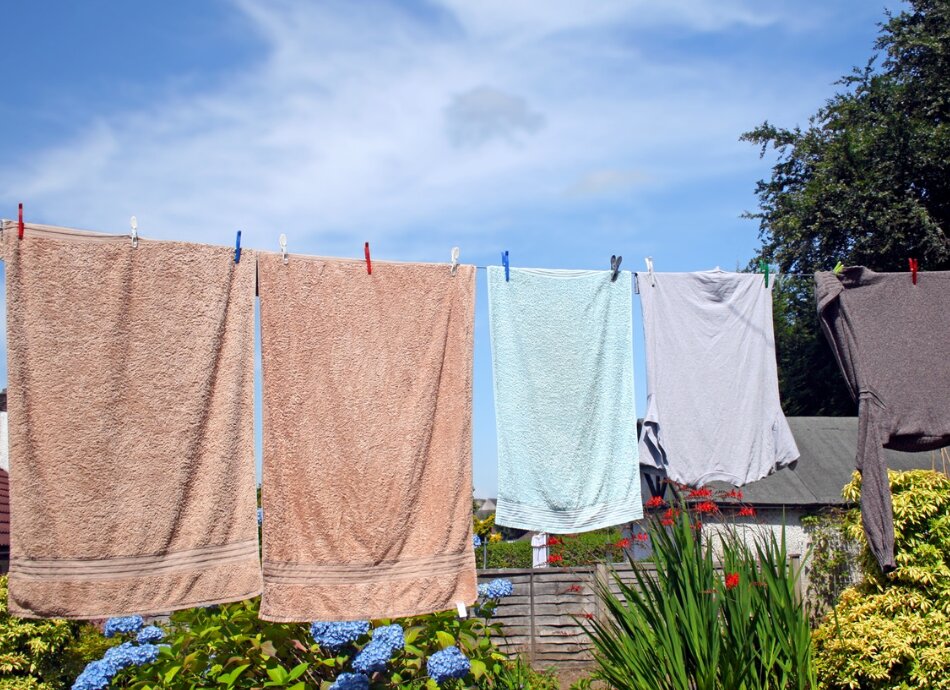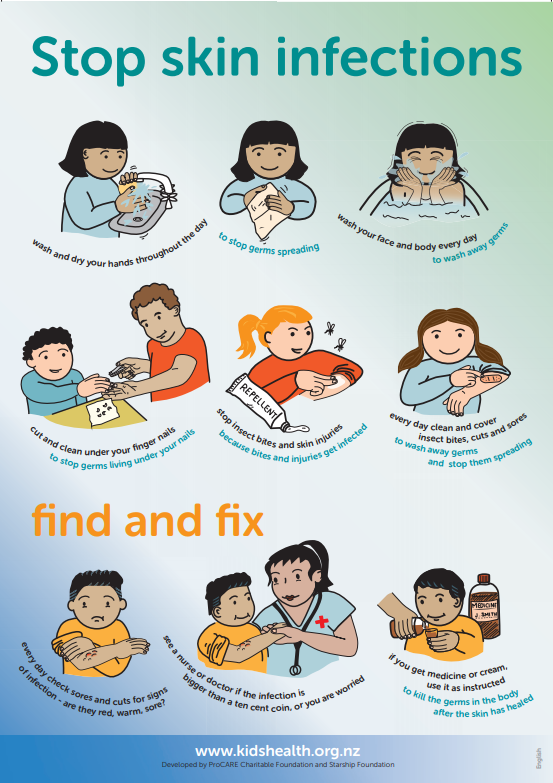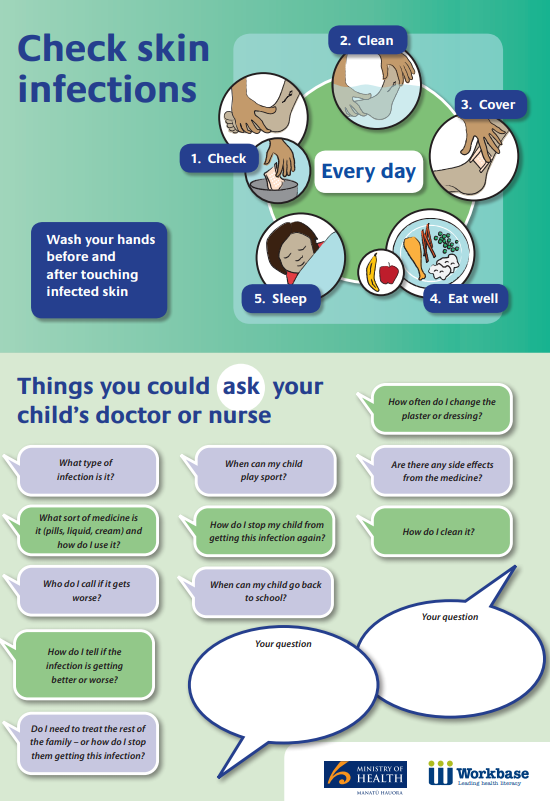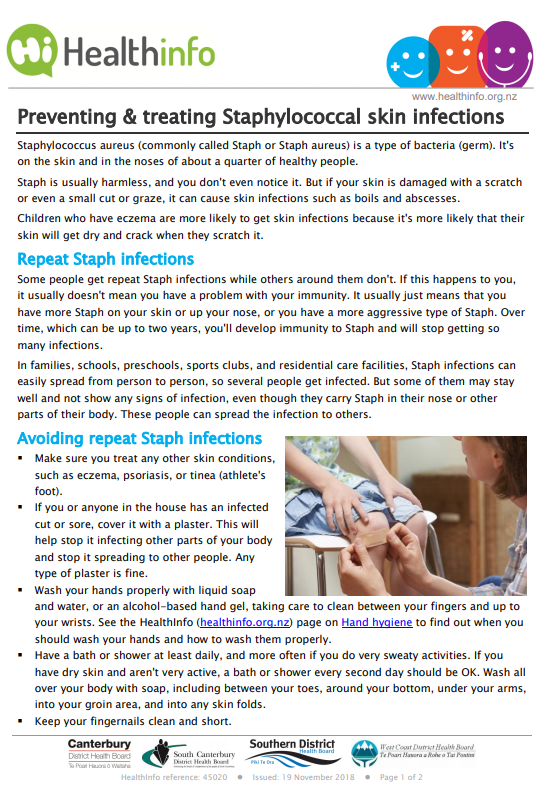Your doctor may advise you to have a bath daily for seven days with an antiseptic such as chlorhexidine. If you don’t have a bath, have a shower and put the antiseptic straight on your skin like soap (undiluted). Leave the antiseptic on your skin (especially under your armpits, breasts, groin and bottom) for at least five minutes before washing off.
Alternatively, your doctor may recommend you have a bleach bath 2 or 3 times for 1 week, by adding household bleach to your bath or tub with warm water. Bleaches come in different strengths. When preparing a bleach bath, it is very important that the bleach is diluted in the correct amount of water. Do not apply undiluted bleach directly to the skin. This can cause severe burns and is very harmful. Household bleach comes in different strengths, Here is guidance on how to prepare a bleach bath.(external link)
Low or no data? Visit zero.govt.nz, scroll down the page then click on our logo to return to our site and browse for free.
Staph skin infections – recurring
And how to stop them
Key points about recurring staph infections
- Staphylococcus aureus (or ‘staph’) is a kind of germ (bacteria) that is a common cause of skin infections.
- For most people staph skin infections clear up after treatment and seldom return, but for some people staph skin infections can recur or be an ongoing problem.
- If you have a staph skin infection it must first be treated with antibiotics from your healthcare provider
- It's also important to wash towels and sheets (in hot water if you can) at the beginning of your treatment and anytime they become contaminated by pus or discharge from boils.
- If you have recurrent Staph skin infections, your healthcare provider may also recommend some of the following strategies to prevent them from returning (see below).

Because staph bacteria tend to live in the nose, your doctor may advise you to apply an antibiotic ointment (such as fusidic acid ointment or mupirocin) to your nostrils 3 times a day for 7 days to help clear it up.
- Use a clean cotton bud for each application.
- Insert just enough so that the tip of the bud goes into the nose – about 1 cm – for each application
- Apply ointment fully around the inside surface of each nostril.
Sometimes nasal ointment and antiseptic baths are not enough to get rid of staph skin infections for good. In such cases your doctor may give you a longer course of antibiotics (sometimes 1 week on, 3 weeks off for up to 6 months). Your doctor will give you clear instructions and a diary to help.
Have everyone in your home do these things:
- Clean scratches, insect bites or other wounds and cover them with a plaster.
- Wash and dry hands well and often, using water and soap or an alcohol-based gel sanitiser.
- Keep fingernails clean and short.
- Don’t share towels, sheets, soaps, clothing, razors, make-up or other personal items.
- Throw away used razors.
- Change underwear every day.
- Have a bath or shower at least once a day.
- Treat any other skin conditions, such as eczema, psoriasis or athlete's foot (tinea).
- Make sure towels and clothes are dry before you use them
You should also regularly do these things in your home:
- Wash towels and sheets regularly in hot water and dry them well, or add a capful of bleach to the wash cycle.
- Clean bench tops, doorknobs, bathtubs and toilet seats often.
- Clean all hard surfaces, including bathrooms and floors, with detergent and water.
- Change towels and sheets once a week.
- Regularly vacuum carpets, rugs, mattresses and electric blankets.
- Wash pet bedding regularly, especially dog bedding.
- Wash and dry your child’s sports clothing after each match.
The following links provide further information about stopping staph skin infections. Be aware that websites from other countries may have information that differs from New Zealand recommendations.
Bleach baths – how to give your child a bleach bath(external link) Plunket, NZ
Staphylococcal infections (staph)(external link) Plunket, NZ
Staphylococcal infections(external link) The Royal Children’s Hospital Melbourne, Australia
Staph infection(external link) NHS, UK
Staph infections(external link) Nemours KidsHealth
When and how to use bleach baths for your child with eczema(external link) KidsHealth NZ
Resources
Stop skin infections(external link) Northern Region Skin Prevention Group with support from Health Literacy NZ, KidsHealth, Procare Charitable Foundation and Starship Foundation NZ. Available in the following languages: English(external link), te reo Māori(external link), Samoan(external link), Tongan(external link)
Check skin infections – things you could ask your child's doctor or nurse(external link) Ministry of Health and Workbase NZ
Preventing & treating staphylococcal skin infections(external link) HealthInfo, NZ, 2018
References
- Bleach baths in patients with skin infections(external link) Dermnet NZ, 2015
- Managing skin infections in Māori and Pacific families(external link) BPAC, NZ, 2012
- Staphylococcal skin infection(external link) DermNet NZ, 2015
Brochures

Northern Region Skin Prevention Group with support from Health Literacy NZ, KidsHealth, Procare Charitable Foundation and Starship Foundation NZ
Available in the following languages:
Te reo Māori
Samoan
Tongan

Ministry of Health and Workbase NZ

HealthInfo, NZ, 2018
Credits: Healthify editorial team. Healthify is brought to you by Health Navigator Charitable Trust.
Reviewed by: Dr Arna Letica, FRNZCGP, Auckland
Last reviewed:
Page last updated:





